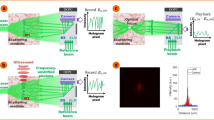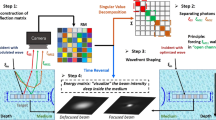Abstract
Light focusing plays a central role in biomedical imaging, manipulation and therapy. In scattering media, direct light focusing becomes infeasible beyond one transport mean free path. All previous methods1,2,3 used to overcome this diffusion limit lack a practical internal ‘guide star’4. Here, we propose and experimentally validate a novel concept called time-reversed ultrasonically encoded (TRUE) optical focusing to deliver light into any dynamically defined location inside a scattering medium. First, diffused coherent light is encoded by a focused ultrasonic wave to provide a virtual internal guide star. Only the encoded light is time-reversed and transmitted back to the ultrasonic focus. The time-reversed ultrasonically encoded optical focus—defined by the ultrasonic wave—is unaffected by multiple scattering of light. Such focusing is particularly desirable in biological tissue, where ultrasonic scattering is ∼1,000 times weaker than optical scattering. Various fields, including biomedical and colloidal optics, can benefit from TRUE optical focusing.
This is a preview of subscription content, access via your institution
Access options
Subscribe to this journal
Receive 12 print issues and online access
$209.00 per year
only $17.42 per issue
Buy this article
- Purchase on Springer Link
- Instant access to full article PDF
Prices may be subject to local taxes which are calculated during checkout



Similar content being viewed by others
References
Vellekoop, I. M. & Mosk, A. P. Focusing coherent light through opaque strongly scattering media. Opt. Lett. 32, 2309–2311 (2007).
Vellekoop, I. M., van Putten, E. G., Lagendijk, A. & Mosk, A. P. Demixing light paths inside disordered metamaterials. Opt. Express 16, 67–80 (2008).
Yaqoob, Z., Psaltis, D., Feld, M. S. & Yang, C. H. Optical phase conjugation for turbidity suppression in biological samples. Nature Photon. 2, 110–115 (2008).
Primmerman, C. A., Murphy, D. V., Page, D. A., Zollars, B. G. & Barclay, H. T. Compensation of atmospheric optical distortion using a synthetic beacon. Nature 353, 141–143 (1991).
Popoff, S. M. et al. Measuring the transmission matrix in optics: an approach to the study and control of light propagation in disordered media. Phys. Rev. Lett. 104, 100601 (2010).
Vellekoop, I. M., Lagendijk, A. & Mosk, A. P. Exploiting disorder for perfect focusing. Nature Photon. 4, 320–322 (2010).
Ishimaru, A. Wave Propagation and Scattering in Random Media (Academic Press, 1978).
Fink, M. et al. Time-reversed acoustics. Rep. Prog. Phys. 63, 1933–1995 (2000).
Lerosey, G., De Rosny, J., Tourin, A. & Fink, M. Focusing beyond the diffraction limit with far-field time reversal. Science 315, 1120–1122 (2007).
Mahan, G. D., Engler, W. E., Tiemann, J. J. & Uzgiris, E. Ultrasonic tagging of light: theory. Proc. Natl Acad. Sci. USA 95, 14015–14019 (1998).
Wang, L. H. V. Mechanisms of ultrasonic modulation of multiply scattered coherent light: an analytic model. Phys. Rev. Lett. 87, 043903 (2001).
Gunter, P. Holography, coherent-light amplification and optical-phase conjugation with photorefractive materials. Phys. Rep. 93, 199–299 (1982).
He, G. S. Optical phase conjugation: principles, techniques, and applications. Prog. Quantum Electron. 26, 131–191 (2002).
Solymar, L., Webb, D. J. & Grunnet-Jepsen, A. The Physics and Applications of Photorefractive Materials (Clarendon Press, 1996).
Ramaz, F. et al. Photorefractive detection of tagged photons in ultrasound modulated optical tomography of thick biological tissues. Opt. Express 12, 5469–5474 (2004).
Xu, X. et al. Photorefractive detection of tissue optical and mechanical properties by ultrasound modulated optical tomography. Opt. Lett. 32, 656–658 (2007).
Gunter, P. & Huignard, J. P. Photorefractive Materials and Their Applications. 1 Basic Effects (Springer, 2006).
Wang, L. V., Jacques, S. L. & Zheng, L. Q. MCML—Monte Carlo modeling of photon transport in multi-layered tissues. Comput. Methods Programs Biomed. 47, 131–146 (1995).
Srinivasan, S. et al. Interpreting hemoglobin and water concentration, oxygen saturation, and scattering measured in vivo by near-infrared breast tomography. Proc. Natl Acad. Sci. USA 100, 12349–12354 (2003).
Acknowledgements
This work was sponsored in part by the National Institutes of Health (grants R01 EB000712, R01 EB008085, R01 CA134539, U54 CA136398 and 5P60 DK02057933).
Author information
Authors and Affiliations
Contributions
X.X. and H.L. contributed equally to the experimental design and study, Monte Carlo simulation, data analysis and writing of the manuscript. L.V.W. conceived the original idea, discussed the experiments and revised the paper.
Corresponding author
Ethics declarations
Competing interests
The authors declare competing financial interests: L.V.W. has a financial interest in Microphotoacoustics and Endra, which, however, did not support this work.
Supplementary information
Rights and permissions
About this article
Cite this article
Xu, X., Liu, H. & Wang, L. Time-reversed ultrasonically encoded optical focusing into scattering media. Nature Photon 5, 154–157 (2011). https://doi.org/10.1038/nphoton.2010.306
Received:
Accepted:
Published:
Issue Date:
DOI: https://doi.org/10.1038/nphoton.2010.306
This article is cited by
-
Phase conjugation with spatially incoherent light in complex media
Nature Photonics (2023)
-
High-gain and high-speed wavefront shaping through scattering media
Nature Photonics (2023)
-
High-resolution non-line-of-sight imaging employing active focusing
Nature Photonics (2022)
-
Depth-targeted energy delivery deep inside scattering media
Nature Physics (2022)
-
Deep laser microscopy using optical clearing by ultrasound-induced gas bubbles
Nature Photonics (2022)



